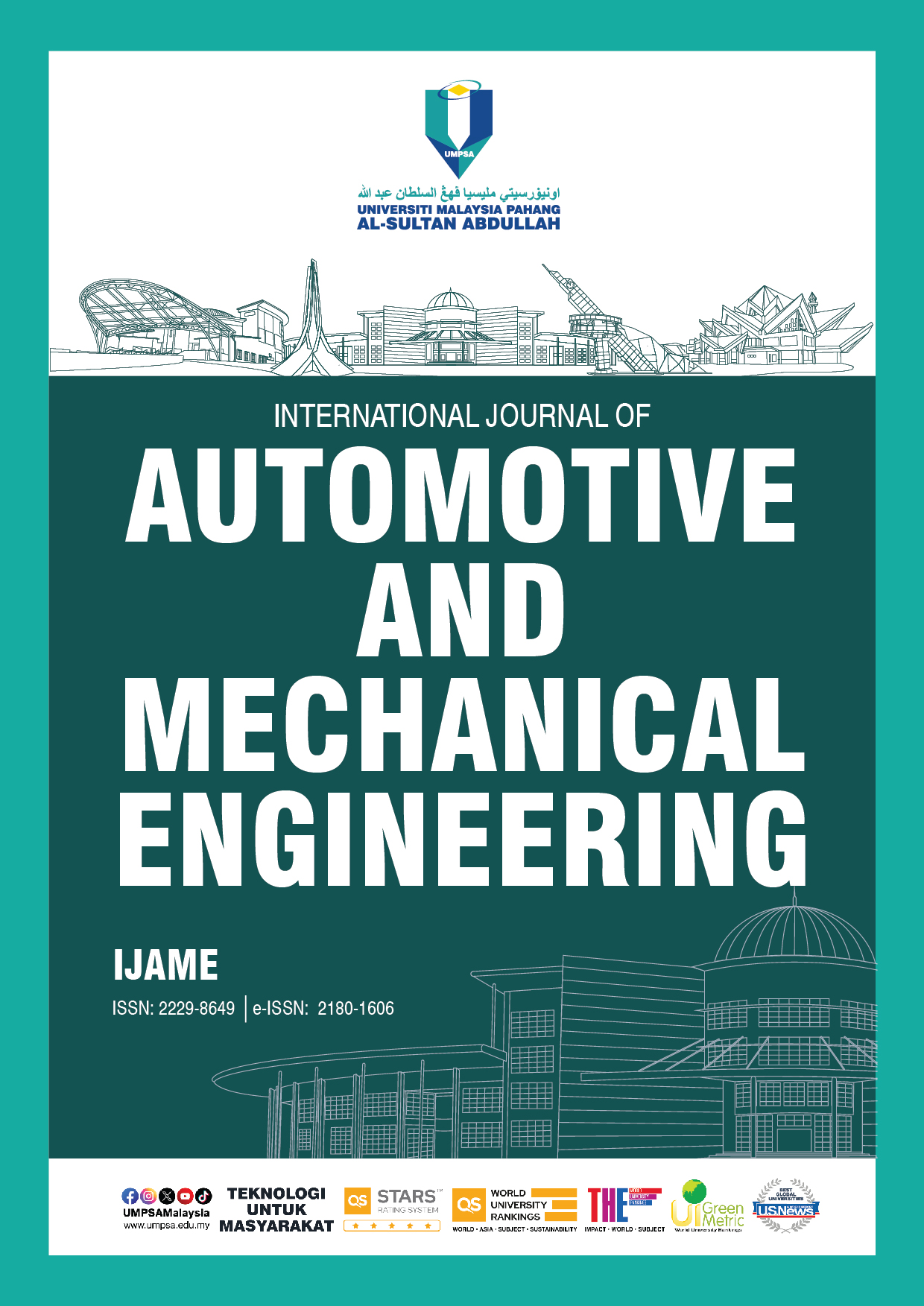Interactive Simulation Framework for Analysing Tracked Mobile Robots in Real-Time
DOI:
https://doi.org/10.15282/ijame.22.1.2025.15.0932Keywords:
Hardware-in-the-loop, Skid-steering, Tracked mobile robot, Unreal engine, Real-time simulationAbstract
Tracked mobile robots play a crucial role in navigating complex terrains for urban search and rescue and military applications, yet verifying their performance in diverse environments remains a challenge. This study introduces an interactive simulation framework using a Hardware-in-the-Loop (HIL) platform to analyse real-time performance, focusing on critical capabilities such as skid-steering, slope handling, and obstacle climbing. By integrating detailed kinematic models with a virtual environment powered by Unreal Engine, the framework delivers precise simulations that closely replicate real-world scenarios. Validation tests revealed a maximum position error of ±8.5838 cm, with mean squared errors of 0.1854 m for the x-coordinate, 0.1486 m for the y-coordinate, and 0.801 radians for the yaw angle in straight-line navigation. Despite higher errors in complex manoeuvers, the results demonstrate the framework's effectiveness in bridging simulation and real-world performance, providing a reliable tool for the design and testing of mobile robots in challenging environments.
References
[1] L. Bruzzone, S. E. Nodehi, and P. Fanghella, “Tracked locomotion systems for ground mobile robots: A review,” Machines, vol 10, no. 8, pp. 648, 2022
[2] B. S. C. Ranjan, U. Pal, S. P. Ojha, V. Srinivasan, and A. Chakrabarti, “Exploring serially connected multi-tracked all-terrain vehicles for improved obstacle climbing performance,” in 14th National Conference on Machines and Mechanisms, NaCoMM 2009, 2020, pp. 279-286.
[3] G. Dimitrakopoulos, A. Tsakanikas, and E. Panagiotopoulos. Autonomous Vehicles Technologies, Regulations, and Societal Impacts, 1st ed. Elsevier Science, 2021.
[4] Z. Szalay, “Next generation X-in-the-loop validation methodology for automated vehicle systems,” IEEE Access, vol. 9, pp. 35616-35632, 2021.
[5] Y. Chen, S. Chen, T. Zhang, S. Zhang, and N. Zheng, “Autonomous vehicle testing and validation platform: Integrated simulation system with hardware in the loop,” in 2018 IEEE Intelligent Vehicles Symposium (IV), Changshu, China, 2018, pp. 949-956.
[6] X. Hu, “Applying robot-in-the-loop-simulation to mobile robot systems,” in 2005 International Conference on Advanced Robotics, ICAR ’05, Proceedings, Seattle, WA, USA, 2005, pp. 506-513.
[7] R. P. Urvina, C. L. Guevara, J. P. Vásconez, and A. J. Prado, “An integrated route and path planning strategy for skid–steer mobile robots in assisted harvesting tasks with terrain traversability constraints,” Agriculture (Switzerland), vol. 14, no. 8, pp. 1206, 2024.
[8] L. Liang, H. Liu, X. Li, X. Zhu, B. Lan, Y. Liu et al., “Model-based coordinated trajectory tracking control of skid-steer mobile robot with timing-belt servo system,” Electronics, vol. 12, no. 3, pp. 122, 2023.
[9] J. Moreno, E. Slawiñski, F. A. Chicaiza, F. G. Rossomando, V. Mut, and M. A. Morán, “Design and analysis of an input–output linearization-based trajectory tracking controller for skid-steering mobile robots,” Machines, vol. 11, no. 11, pp. 988, 2023.
[10] M. Akçakoca, B. M. Atici, B. Gever, S. Oguz, U. Demirezen, M. Demir et al., “A simulation-based development and verification architecture for micro uav teams and swarms,” in AIAA Scitech 2019 Forum, San Diego, 2019, pp. 1917-2305.
[11] M. Nithya and M. R. Rashmi, “Gazebo - ROS - Simulink framework for hover control and trajectory tracking of crazyflie 2.0,” in IEEE Region 10 Annual International Conference, Proceedings/TENCON, Kochi, India, 2019, pp. 649-653.
[12] Z. B. Rivera, M. C. De Simone, and D. Guida, “Unmanned ground vehicle modelling in Gazebo/ROS-based environments,” Machines, vol. 7, no. 2, pp. 42, 2019.
[13] H. Huang, H. Xu, F. Chen, C. Zhang, and A. Mohammadzadeh, “An applied type-3 fuzzy logic system: Practical Matlab simulink and M-Files for robotic, control, and modeling applications,” Symmetry, vol. 15, no. 2, pp. 475, 2023.
[14] A. O. Prasad, P. Mishra, U. Jain, A. Pandey, A. Sinha, A. S. Yadav et al., “Design and development of software stack of an autonomous vehicle using robot operating system,” Robotics and Autonomous Systems, vol. 161, pp. 104340, 2023.
[15] D. T. Tran, T. D. Nguyen, M. K. Tran, and K. K. Ahn, “Development of a hardware-in-the-loop platform for a teleoperation flexibility robotic system,” Applied Sciences, vol. 14, no. 5, pp. 2207, 2024.
[16] U. Davalos-Guzman, C. E. Castañeda, L. M. Aguilar-Lobo, and G. Ochoa-Ruiz, “Design and implementation of a real time control system for a 2dof robot based on recurrent high order neural network using a hardware in the loop architecture,” Applied Sciences, vol. 11, no. 3, pp. 1–16, 2021.
[17] M. Tristano, B. Lenzo, X. Xu, B. Forrier, T. D'hondt, E. Risaliti et al., “Hardware-in-the-loop real-time implementation of a vehicle stability control through individual wheel torques,” IEEE Transactions on Vehicular Technology, vol. 73, no. 4, pp. 4683–4693, 2024.
[18] C. C. Dosoftei, A. T. Popovici, P. R. Sacaleanu, P. M. Gherghel, and C. Budaciu, “Hardware in the loop topology for an omnidirectional mobile robot using Matlab in a robot operating system environment,” Symmetry, vol. 13, no. 6, pp. 969, 2021.
[19] B. Sebastian and P. Ben-Tzvi, “Physics Based Path Planning for Autonomous Tracked Vehicle in Challenging Terrain,” Journal of Intelligent and Robotic Systems: Theory and Applications, vol. 95, no. 2, pp. 511–526, 2019.
[20] M. Abbas and S. K. Dwivedy, “Adaptive control for networked uncertain cooperative dual-arm manipulators: an event-triggered approach,” Robotica, vol. 40, no. 6, pp. 1951-1978, 2022.
[21] C. Liu, Y. Yang, C. Zhang, and S. Yang, “Project-based teaching in control theory education based on V-REP: A cart inverted pendulum case,” Journal of Contemporary Educational Research, vol. 7, no. 4, pp. 18-24, 2023.
[22] K. Shabalina, A. Sagitov, K.-L. Su, K.-H. Hsia, and E. Magid, “Avrora unior car-like robot in gazebo environment,” in Proceedings of International Conference on Artificial Life and Robotics, Oita, Japan, 2019, pp. 116-120.
[23] J. Platt and K. Ricks, “Comparative analysis of ROS-Unity3D and ROS-Gazebo for mobile ground robot simulation,” Journal of Intelligent and Robotic Systems: Theory and Applications, vol. 106, no. 4, pp. 80, 2022.
[24] J. L. Silva Cotta, J. Rakoczy, and H. Gutierrez, “Precision landing comparison between smartphone video guidance sensor and IRLock by hardware-in-the-loop emulation,” CEAS Space Journal, vol. 16, no. 4, pp. 475–489 , 2024.
[25] S. Sahu and A. K. Deb, “Swarm of Quadcopters Position control in ROS Gazebo Simulator,” in 3rd International Conference on Range Technology, ICORT 2023, Chandipur, Balasore, India, 2023, pp. 1-6.
[26] O. U. Acar, L. Güvenç, and E. Altuğ, “Hardware-in-the-Loop Testing of Automatic Lift Dropping System for Heavy Trucks,” Journal of Intelligent and Robotic Systems: Theory and Applications, vol. 98, no. 3–4, pp. 693–703, 2020.
[27] R. Raveendran, K. B. Devika, and S. C. Subramanian, “Brake fault identification and fault-tolerant directional stability control of heavy road vehicles,” IEEE Access, vol. 8, pp. 169229-169246, 2020.
[28] V. Kumar, S. C. Subramanian, and R. Rajamani, “Autonomous emergency braking of a heavy road vehicle using a low-density flash lidar,” IEEE Transactions on Vehicular Technology, vol. 73, no. 2, pp. 1879-1889, 2024.
[29] R. Khan, F. M. Malik, A. Raza, and N. Mazhar, “Comprehensive study of skid-steer wheeled mobile robots: Development and challenges,” Industrial Robot, vol. 48, pp. 142-156 , 2021.
[30] G. Rigatos, “A nonlinear optimal control approach for tracked mobile robots,” Journal of Systems Science and Complexity, vol. 34, pp. 1279–1300, 2021.
[31] H. Li, H. Liu, J. Gai, and X. Li, “Steering control of dual-motor coupling drive tracked vehicle based on PSO PID parameter optimization,” Binggong Xuebao/Acta Armamentarii, vol. 45, no. 3, pp. 916-924, 2024.
[32] J. Gai, C. Liu, C. Ma, and H. Shen, “Steering control of electric drive tracked vehicle considering tracks’ skid and slip,” Binggong Xuebao/Acta Armamentarii, vol. 42, no. 10, pp. 2092-2101, 2021.
[33] G. Yamauchi, K. Nagatani, T. Hashimoto, and K. Fujino, “Slip-compensated odometry for tracked vehicle on loose and weak slope,” Robomech Journal, vol. 4, no. 1, pp. 27, 2017.
[34] J. Liu, Y. Wang, S. Ma, and B. Li, “Analysis of stairs-climbing ability for a tracked reconfigurable modular robot,” in Proceedings of the 2005 IEEE International Workshop on Safety, Security and Rescue Robotics, Kobe, Japan, 2005, pp. 36-41.
[35] A. H. Rajabi, A. H. Soltanzadeh, A. Alizadeh, and G. Eftekhari, “Prediction of obstacle climbing capability for tracked vehicles,” in 9th IEEE International Symposium on Safety, Security, and Rescue Robotics, SSRR 2011, Kyoto, Japan, 2011, pp. 128-133.
[36] A. R. G. Harwood, P. Wenisch, and A. J. Revell, “A real-time modelling and simulation platform for virtual engineering design and analysis,” in Proceedings of the 6th European Conference on Computational Mechanics: Solids, Structures and Coupled Problems, ECCM 2018 and 7th European Conference on Computational Fluid Dynamics, Glasgow, UK, 2018, pp. 1-8.
[37] S. Dogru and L. Marques, “An improved kinematic model for skid-steered wheeled platforms,” Autonomous Robots, vol. 45, no. 2, pp. 229–243, 2021.
[38] M. F. Jaramillo-Morales, S. Dogru, and L. Marques, “Generation of Energy Optimal Speed Profiles for a Differential Drive Mobile Robot with Payload on Straight Trajectories,” in 2020 IEEE International Symposium on Safety, Security, and Rescue Robotics, SSRR 2020, Abu Dhabi, United Arab Emirates, 2020, pp. 136-141.
[39] S. Adinandra and A. Syarif, “A low cost indoor localisation system for mobile robot experimental setup,” Journal of Physics: Conference Series, vol. 1007, 2018.
[40] M. Irfan, S. Dalai, K. Kishore, S. Singh, and S. A. Akbar, “Vision-based guidance and navigation for autonomous MAV in indoor environment,” in 2020 11th International Conference on Computing, Communication and Networking Technologies, ICCCNT 2020, Kharagpur, India, 2020, pp. 1-5.
[41] M. F. Sani and G. Karimian, “Automatic navigation and landing of an indoor AR. Drone quadrotor using ArUco marker and inertial sensors,” in 1st International Conference on Computer and Drone Applications: Ethical Integration of Computer and Drone Technology for Humanity Sustainability, IConDA 2017, Kuching, Malaysia, 2017, pp. 102-107.
[42] W. R. Norris and A. E. Patterson, “System-level testing and evaluation plan for Field Robots: A Tutorial with test course layouts,” Robotics, vol. 8, no. 4, pp. 83, 2019.
[43] F. Mihalič, M. Truntič, and A. Hren, “Hardware-in-the-loop simulations: A historical overview of engineering challenges,” Electronics, vol 11, no. 15, pp. 2462, 2022.
Downloads
Published
Issue
Section
License
Copyright (c) 2025 The Author(s)

This work is licensed under a Creative Commons Attribution-NonCommercial 4.0 International License.







